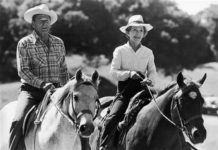
I couldn’t ask about her death. Not that I was asked not to, I couldn’t.
Twenty years after the passing of Selena Quintanilla-Perez, the people of Corpus Christi, Texas — the city that raised the Tejano entertainer alongside the Quintanilla family — speak of her as if she’s still alive today, but remember her as if she passed just yesterday.
Remembering Selena: 15 Key Moments
Selena’s father, Mr. Abraham Quintanilla, her sister, Suzette Quintanilla-Arriaga, and her brother, Abraham Quintanilla III (also known as “A.B.”), dedicate themselves to preserving Selena’s life, and her presence can be felt through out the hushed, at times ominous, heart of the Texas city. And yes, while life has changed in Corpus Christi since Selena was killed on March 31, 1995, it also feels as if it’s stopped.
In every corner of Corpus Christi’s Hi-Ho Restaurant on 3703 Morgan Avenue — one of Selena’s favorite hometown restaurants — she’s there. The walls are covered with her signature smile, traced with red lipstick. The one exception is a painting which hangs in middle of the main dining area. Selena’s eyes are closed, and though she’s not holding a mic, her lips are slightly parted as if ready to belt passionately.
The morning Selena was shot and killed by Yolanda Saldívar, her father was having breakfast at Hi-Ho. Estella Garcia, a waitress and co-manager at the Tex-Mex restaurant, says Quintanilla received a call at the restaurant that alerted him that Selena had yet to return from a meeting with Saldívar. “I heard him say, ‘She’s not back yet?'” Garcia recalls.
Selena had met with Saldívar earlier that morning to discuss business matters, according to reports. Earlier in the month, Saldívar was accused of embezzlingmoney from Selena’s fan club and fashion boutiques. Selena took her to the Doctors Regional Hospital, after Saldívar claimed she was raped in Mexico. The doctors suggested for Saldívar to visit a hospital in San Antonio since the alleged rape occurred in another jurisdiction, according to trial testimonies. The duo returned to the Days Inn motel where Saldívar was staying at. An argument broke out, and Saldívar shot Selena, severing an artery. She ran to escape Saldívar, collapsing in the motel lobby after loss of blood. Saldívar was sentenced to life in prison with possibility of parole in 30 years (2025).
Hot Latin Songs | Top Latin Album
Selena passed before finishing her crossover album, Dreaming of You. The sixth studio album was released posthumously on July 18, 1995, and ultimately became her first No. 1 album on the Billboard 200 chart. Selena earned 7 No. 1s on the Hot Latin Songs, with “Tu Solo Tu” holding the top slot for 10 consecutive weeks. Seven of her albums peaked at No. 1 on the Top Latin Albums chart, with her crossover album, Dreaming Of You, staying at No. 1 for 44 consecutive weeks.
When walking into Hi-Ho with Mr. Abraham Quintanilla on March 12 we’re greeted by waitresses — majority Mexican-American, inviting and warm — wearing T-shirts with Selena’s name printed in the front. On the back, there’s a tracing of her figure; she’s donning a leather jacket and long messy tresses drawn in motion. In Corpus, you see and hear of the many sides of Selena, from the demure to the rebellious to the coquettish. It’s these many facets that captivate fans worldwide to this day. Selena had style that was admired to the point of imitation, songs that you could find yourself in, and a spirit that when heard about makes you wish you’d experience at least one minute with her.
I wondered, before meeting Quintanilla, whether he was the authoritarian figure we saw portrayed in the 1997 Gregory Nava-directed film titled after her late daughter. He is a reserved man, and I found him a bit defensive. But it didn’t take me long to figure out why.
Every 10-15 minutes, a restaurant customer coming or going would walk over and gently tap Quintanilla on the shoulder, whether to simply say hello, remind him of an event they’d love his support or assistance on, whisper a favor or just reminisce. And most of those exchanges were in regards to Selena. Everywhere he turns, someone wants (one more) piece of Selena, almost as if she was his key to the city. Quintanilla’s grasp on Selena’s legacy only tightens with each conversation about her. Twenty-years after her passing, he still protects his daughter; he’s committed to having Selena be remembered in a light he believes is truest to her spirit. “One thing my dad said is that he never wanted her to be forgotten,” Suzette says of her father. “And she hasn’t been.”
Less than three miles away from Hi-Ho Restaurant is Q-Productions, Inc., an entertainment company Quintanilla founded in 2003. The studio has several pockets (recording and post-production studios, offices, performance stage), secret hallways that lead to one another, and a Selena museum at the center. One open room holds all of the singer’s plaques, awards, most memorable outfits — like the glistening dark magenta one-piece she wore at her last show ever, at the Houston’s Astrodome — as well as her collection of glass eggs. The egg collection stands in a tiered glass display case just outside the office of Selena’s sister’s Suzette, who handles Q-Productions’ licensing.
Selena’s presence is overwhelming; All I could think of when speaking to Suzette is, “Is it ever too much?”
“Yeah,” she answers. “Losing someone you’re an emotional roller coaster, and it will forever be that way. Sometimes it hurts and sometimes it hurts a lot and sometimes I don’t want to be here. It depends on how I’m feeling that day…”
Suzette falls silent.
“For the most part, it’s a good thing. You can hear her fans talking, and it’s really cool to be honest with you,” she continues. “I can hear the little ones talking about the egg collection outside my door, and the mother explaining as to why Selena liked eggs. Then there are times when little ones talk amongst themselves, talking about her. That brings me so much joy, because they weren’t even a thought when she passed away but yet they have this love for her, that’s because her parents are passing on her legacy on to them.”
Amongst those who visit the museum, the majority are Latino families spanning several generations. Parents tell their kids, both girls and boys, about Selena’s legacy as they take a step from one of Selena’s popular outfits to another; all while her discography plays from the sound system. Girls knee-high can be heard singing along, even reciting Selena’s giggles and adlibs from songs such as “Techno Cumbia” and “Tu Solo Tu.”
Throughout her six-studio albums discography, you’d find a champion for love. Selena was one to brazenly fall at the heels of love even if it hurt (“Tu Solo Tu”). And when enough was enough, she didn’t hesitate to walk away from what she didn’t deserve (“Sí Una Vez”). She was a hopeless romantic, willing to lose as long as she could say she had loved (“No Me Queda Mas,” “Como La Flor”). She performed such songs of love with such exuberance and devotion, it evoked fans of all ages to gravitate towards her, sparking nostalgia amongst those who’ve loved and daydreams for those who wish to once.
Selena — whose primary language was English — sung in Spanish. She appealed to a Latino audience from the start of her career, with determination to uphold her heritage. As Suzette told me, many fans identified with her because she had long dark hair, spoke both languages and was proud of her culture, no matter what generation she was (she was third). Selena was Mexican enough, and American enough.
Suzette expands, “I’m very proud of of the fact that I’m Latina woman. I’m very proud of my culture and of my heritage, but because we grew up here in south Texas, most people speak English. So my Spanish isn’t all that, so it’s harder for me to speak it or express myself as freely, so I prefer to speak English when doing a Spanish interview. I feel bad because I don’t want those who are watching to think I’m not proud of who I am as a Latina, but I just don’t want to look like a fool,” she says. “Selena — as the main singer of the group — was worried. She didn’t come off as if she was embarrassed as who she was as a Mexicana. But that’s why she learned it [Spanish], and learned it very well.”
Suzette, who played the drums in their band, Selena y Los Dinos, stopped playing once Selena passed: “I couldn’t imagine playing without her…” Selena’s widower, Chris Perez, and her brother A.B. continued their careers as musicians, though Perez has struggled to avoid being left in the shadow of Selena that many people have cast on him.
“Soon after she passed, I started getting back into my music. I always felt this heaviness from people that wanted to relate to me as the widower, and I was working so hard to do other things,” Perez shares. “I might have overreacted; a kind of a knee-jerk reaction to it was to distance myself as far away from what Selena stood for for her fans. Every time I did something, no matter how hard I worked at it, I would always be remembered as something else that I didn’t want necessarily want to be remembered as, as like the widower.”
A.B. solely produced and co-wrote all of Selena’s music alongside Pete Astudillo and Ricky Vela (except her Billboard 200 No. 1 album, Dreaming of You), and says he fell into a “dark place” for the first 15 years after her passing. Selena was the only artist A.B. worked with before she passed. “A memory can’t make you feel un-sad. If you’re going to be sad and be in a slump, you’re going be in that slump. You have to tell yourself, you need get out of this slump because she would want me to get out of this slump,” he says
Suzette dealt with Selena’s passing in her own way: “When everything happened, with losing her, I literally lost memory. I know that sounds odd,” Suzette explained. “It took a lot from me… I was in a fog, you might say. I can’t tell you what I did, who I was with, anything. I’ve noticed I can’t remember a lot of things. The only thing I can associate that with, is [that] it [started] happening around the time that I lost her. It blew my mind that I lost memory. ”
One day or 20 years later, Selena’s death isn’t just folklore but an every day reality for her family, as well as her still-mourning fans.
“Somebody asked me the other day, ‘If she was to be right in front of you what would you tell her?’ I wouldn’t even tell her anything. I’d totally hug her. They’re like, ‘what would you tell he after that?’ I’m like, ‘No! I would hug her, hug her and hug her, and not let her go.’ I miss her.”


















